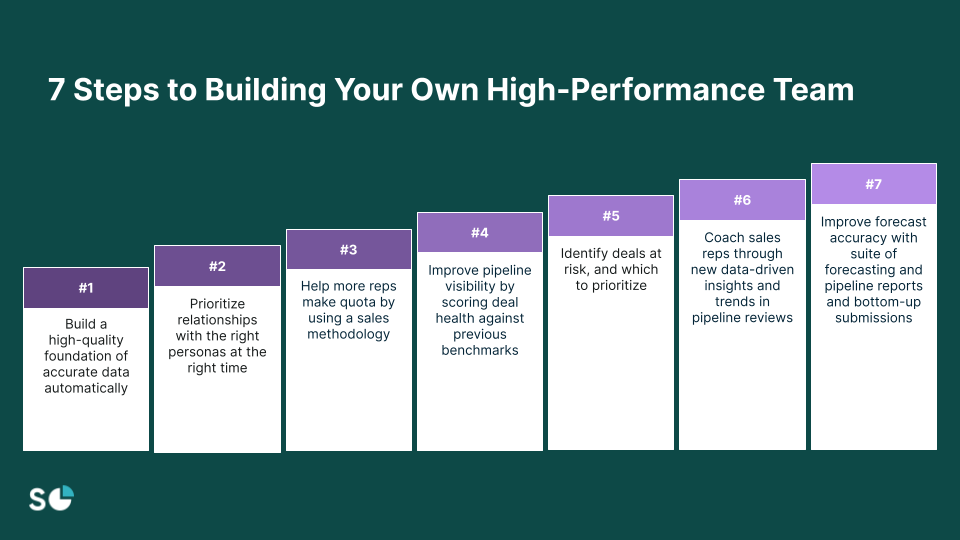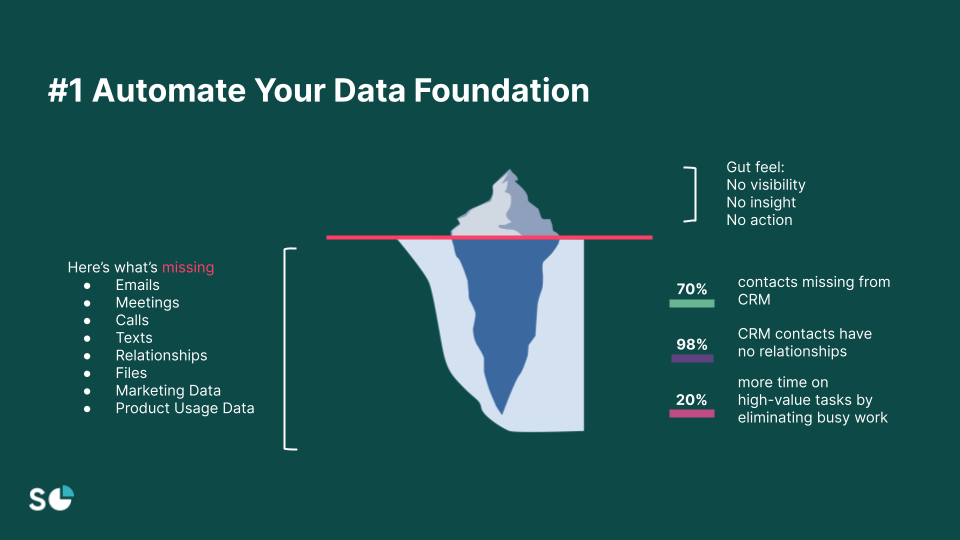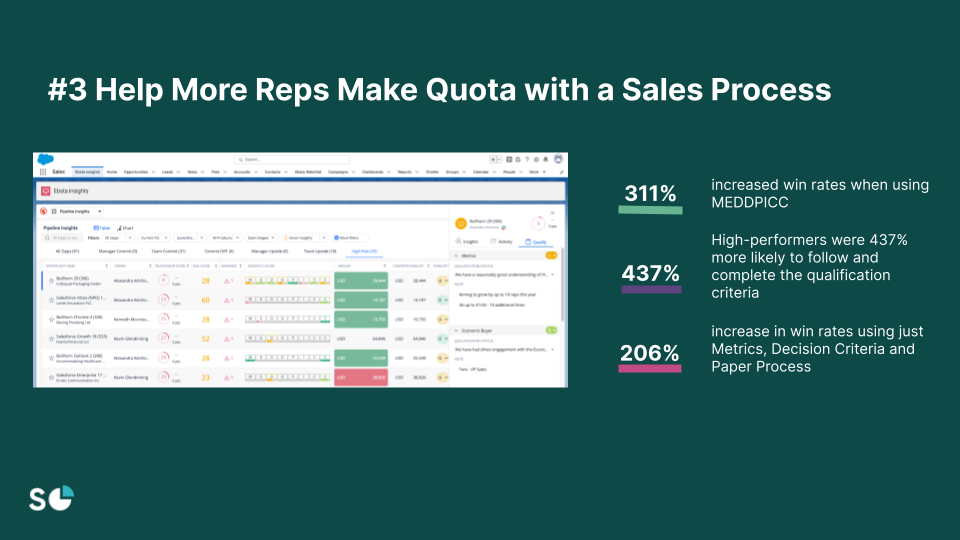Lessons from Analyzing $3m Deals on how to grow SaaS revenue
Growing SaaS revenue in 2023 isn’t easy. You need a comprehensive understanding of data-driven strategies that can set your team apart. Guy Rubin, Founder and CEO at Ebsta shows you seven critical steps that will not only double your sales win rates but also revolutionize your approach to sales.
From automating data collection to fine-tuning your engagement strategies, Guy’s strategies empower you with the knowledge to navigate the complexities of modern sales, reduce sales cycles, identify deals at risk, and foster a culture of data-driven decision-making to grow SaaS revenue in 2023 and beyond.
The below is a lightly edited transcript of Guy’s keynote speech at SaaSOpen 2023.
What do you need to do to 2x your sales win rates and grow SaaS revenue?
Rather than focusing on the ones that didn’t achieve, what I wanted to do is bring to the table today some of the insights of what the high performing sales teams are actually doing. Probably one of the key trends we’re seeing is that those certainly in B2B relationships drive revenue.
Understanding what relationships you have and really double downing and making sure that those relationships are strong, is vital not just on winning new business, but also retaining and upselling to existing customers.
We also saw that you can double your win rates with better sales methodologies. Introducing a med pick or a medic or a band type process to do your qualification and really making sure it’s being used correctly.
It’s not just a box ticking exercise. You are really working out whether you should continue to invest in the sales process to move forward or not, rather than just ticking a set of boxes.
These are the seven steps we set out. That we saw in the information that we were processing, to build this high performing sales team. I’m going to take you through all seven.

Why do most CRMs only have 70% active contacts? How do you fix it?
The first one is, probably the least sexy, but one of the most important, is this idea of building data, having good quality, consistent data in your CRM. If in 2023 you’re still relying on humans to log their activity, create contacts or keep them up to date, it’s time to rethink.
We can see that the CRM itself is missing all sorts of interesting data. We have been doing this now for a decade, and we’ve never found a company with more than 70% of their active relationships in CRM. And usually it’s less than 50%. We need to stop relying on humans logging their activity and creating contacts. By taking that responsibility away from them, the CRM becomes a much more complete and accurate place to spend time.
Automating the logging of activity, creating contacts, doing all that on their behalf, making sure that it becomes a system of record that includes all the data that you need is key. For what it’s worth, we have an engine that you can turn on, and it’ll solve all that in seven days.
Of the records, we see a lot of companies still talking about the value of having a large database, but then when we analyze the data, we can see that there really is no relationship with 98% of the contacts they’ve registered in the CRM. There is no relationship there.
They shouldn’t be in the CRM. You shouldn’t be focusing on how big the database is, but about maintaining the relationships you have. We can take away all this busy work, all these distractions for the sales team by taking away all that admin burden away from them and solving the data issues.

How does enhancing relationship strength and engagement score impact win rates in the sales process and help grow SaaS revenues?
Once we’ve got a process in place that’s managing the data on their behalf, the next big challenge is about understanding what the impact of relationships are on growing SaaS revenue. And this is one of the single biggest things you can do is drive activity and relationship strength. Because the nature of what we do is we score every relationship a business has out of 100.
It’s not unusual to end a sales process with an engagement score of between 60 and 80, a good level of engagement. What we can see here is that you can 3X your win rates by increasing the engagement from good to great. When you’ve got late stage multithreaded deals that’s getting the sales team engaging, you’re leaning in. If the C-suite can help, you can have a big impact on the win rates.

How can you rate engagement? What engagement?
We take a feed of your call records, your email traffic, your calendar events, your CRM and things like inbound is worth a lot more than outbound, the velocity of engagement. The number of activities going back and forth and the strength and momentum of engagement.
What we do is when we onboard a customer, we’ll go back over the last four quarters and find all the momentum that you had on deals that you closed in the past to really understand how much engagement you had so that you can start to build a benchmark.
We can also see it has a big impact on sales cycle as well. It reduces sales cycle. If you’ve got good, high levels of engagement, you can reduce the time it takes to close a deal.

How does timely engagement with the right stakeholders influence the speed of closing a deal in the sales process?
We also know that engaging with the right people at the right time is key. This historical analysis we do when we onboard a customer will show you what the optimal sales cycle actually looks like because it’s not always about engaging with the economic buyer in stage one of the sales process.
More often than not, there’s a lot of value in getting momentum with a key stakeholder, a key influencer to get those deals over the line. Really understanding that the impact of getting the right engagement with the right stakeholder at the right time, you can really boost the speed in which a deal is closed by 170%.

How does implementing qualification metrics grow SaaS revenue by 3x?
It’s all about helping reps with a much more structured and data driven approach to the way that they review their pipeline. What we’re looking at here is a dashboard we use. We have within the product. It’s actually inside, in this case, inside Salesforce or inside HubSpot.
What we can see instantly is, the impact of using a qualification metric on revenue is 3x. We want to see them using this qualification metric. We bring it up here as part of the review process. But if they’re not filling that information in, then we’re not going to be able to capture it, and we can’t report on it.

How can you use data to reduce sales cycles by 30 days or more? Does this grow SaaS revenue?
You need to identify the factors that are helping you close more deals. You’ve got the data. It all sits within your business. It’s just in the wrong place. It might be sitting in the mailboxes, the calendars, the CRM, but what we need to do is bring it together and make it visual.
How many stakeholders should you be engaging with in the different types of sales cycles that you’re running? Knowing that means that when the salesperson tells you how great they’re doing and, “Leave me alone, the deal will definitely happen.”
You’re able to say then, “Well, I’m pleased you’re doing well, but look, if we have one more stakeholder involved, we could double our win rates. Or if the engagement with the CFO was gone from 27 to 53, we could reduce the sales cycle by 30 days.” Knowing the data, so you can use it to drive the activities that you want is absolutely vital.
There are other data points you should be considering as well. Different businesses work in different ways, but understanding the impact of intent, impact of product usage, for example, on renewals or even if you’ve got a free trial is really key. So trying to understand the signals that grow SaaS revenue is vital.
How does data on deal pacing and rep performance help in making informed decisions about team promotion and adjustments?
As part of the quarter of the insight reports we deliver our customers, we also give them a breakdown of every rep within the business. We’ll give you a kind of traffic light signal on how they’re pacing.
Understanding how much coverage every rep needs to hit quota and is that pacing upwards or downwards, quarter on quarter.
Understanding the DNA of the deals really gives you the data you need to be able to have proper reviews of which reps should you be keeping promoting and which ones aren’t working out if without the data, it’s all gut feel.
How does understanding the granular details of each deal and identifying deals at risk improve the efficiency and productivity of the sales team?
What you can see is two different deals that look identical on the outside. But when we start to dive into the deals, we find they’re not identical at all. What we find is that actually one deal has only had one activity in the last seven days, while the others had six.
One deal has the opportunity amounts decreased and ones increased. Understanding the granular detail behind every deal and having it in a simple, easy-to-use dashboard in the CRM means that you are able to see very quickly the deals at risk. Because from the analysis we’ve done, only 30% of the opportunities opened, closed won.
The deals that close last spend twice as long in Pipe as deals that close won. Now how expensive is that? How much inefficiency is that in the sales process? If we can reduce the time spent on deals that aren’t going to close, we can have a material impact on the productivity of the sales team and growing SaaS revenue.

Why is consistency and a centralized platform critical for conducting pipeline reviews and how does it contribute to making improvements in the sales process?
When you get to your pipeline reviews, these are the seven questions you should be asking, and you should be able to do this from a single dashboard inside your CRM. If you’re not using something like this, and you’re relying on spreadsheets, it’s time to step up to this type of platform.
Really getting everything in one place, having a consistent way to digest everything. Consistency is key if you want to run experiments and start to make improvements because small incremental improvements lead to exponential results.

Why is real-time, data-driven forecasting essential for sales teams and how does it streamline the process of updating and submitting forecasts?
Finally, aligning the teams to this data-driven forecasting approach. What we want to do is make it super easy for the individual contributors to update their forecast in real time, anytime. Not once a week as a task they have to do before they leave for work on a Friday afternoon. We want it to be consistent and easy for them to digest. It should be visual.
You can see here, for example, a summary of what’s happened this week. Where were we at the beginning of the week? What positive things happened? What negative things happened? All of that’s easy to digest, and it makes it super easy for the team to submit their own forecast.
The data will tell you what we think the forecast will be, and then we can see how they deviate from that number. Once the rep’s done it, we make it easy for the managers to also make the changes and submit their forecast up to the board, and then it goes to the senior management.
Those are the seven steps that I think you should be thinking about when you’re trying to build this data-driven sales team and grow SaaS revenue.

Do you get pushback from the sales guys?
Everyone wants to win. The sales guys will always be defensive in their one-to-ones, right? You end up with this combative experience where the sales guys are telling you how great they’re doing, and the managers are telling you that they don’t think the deals are good enough to complete. What we need to do is move their way from that into a much more coaching experience where you’re showing them graphically.
Frankly, the sales guys and most of the sales managers aren’t particularly strategic in their thinking. What we need to do is make it simple. Give them graphics and pictures to understand the influence of different outcomes.
If we want them to engage with more stakeholders, rather than just having this debate of, “Oh. They all love me. I’ve spoken to everyone. I need to. Leave me alone.” “Okay. That’s great, but look, if you have one more stakeholder involved, we can double our win rates.” Understanding the impact of momentum and engagement to grow SaaS revenue.
If the reps telling you how great they’re doing, but no one’s actually spoken to anyone at the C-suite or hasn’t actually engaged with the customer in the last 14 days, you know that that’s not real. But you need to have the data at your fingertips to be able to have that collaborative conversation.
And ultimately, the history that you’ve got in your business will give us the data we need to benchmark what good looks like.
How does understanding the unique ‘DNA’ of different sales teams aid in tailoring go-to-market strategies and tracking the performance of individual contributors?
The more complex the deal, the more stakeholders involved, the more momentum you need. Where this doesn’t work is transaction based businesses. If you are a consumer company, or you are you’re selling sneakers, you don’t need to maintain relationships over time. Okay? Anything that’s B2B, the DNA of the SMB team is going to be different to the DNA of the enterprise team, but the data behind it still is going to be just as valid. You may have different go-to-market strategies.
The quarterly insight reports we deliver as well as the platform will give you the DNA all the way down, not just individual teams or products, but down to the individual contributors. You can see how they’re all pacing over time. Are they moving in the right direction, or has something gone wrong where they’re trending in the wrong direction.
How does analyzing past deal data help in understanding the optimal level of engagement and involvement of different stakeholders at various stages of the sales funnel?
The understanding how multithreaded you need to be at different stages is key here. At the top of the funnel is one thing, and knowing which entry point is giving you the best outcome is important. Let’s do the analysis on the 50 deals that have closed one and lost and 100 that’ve lost as well. The data will tell us whether being too multithreaded at the early stages is having a negative effect. But we can also take a look at the positive impact of being multithreaded at stage two or three or four. When should the CFO get involved?
Is it at what stage gives you the optimal outcome and how much engagement do you need with the CFO? Who within your business should be engaging with the CFO at that stage, which is having the best outcome. The data you’ve got within your business, the analysis that we can do, not what they’ve chosen to log in CRM, but the actual activity that took place.
The emails that took place, the calls that took place, the meetings that took place. By analyzing that data, we can show you what good looked like for different types of deals, and you can start to use that as a playbook and evolve it as you go.
Key Takeaways on how to grow SaaS revenue in 2023:
- Data-Driven Foundation: Build your B2B SaaS business on a strong data-driven foundation. Ensure high-quality, automated data collection and management in your CRM system to make informed decisions.
- Customer Relationship Focus: Prioritize enhancing customer relationships and engagement scores. Strong relationships not only lead to higher win rates but also contribute to customer retention and upselling opportunities.
- Optimized Engagement: Focus on timely engagement with the right stakeholders at various stages of the sales process. This targeted approach can significantly accelerate deal closures and boost revenue.
- Structured Qualification Metrics: Implement structured qualification metrics to assess the viability of deals accurately. This helps you manage your pipeline effectively and drive revenue growth.
- Efficiency and Consistency: Streamline your operations by centralizing data and pipeline reviews. Consistency in your approach enables better decision-making, faster improvements, and ultimately, exponential revenue growth.










